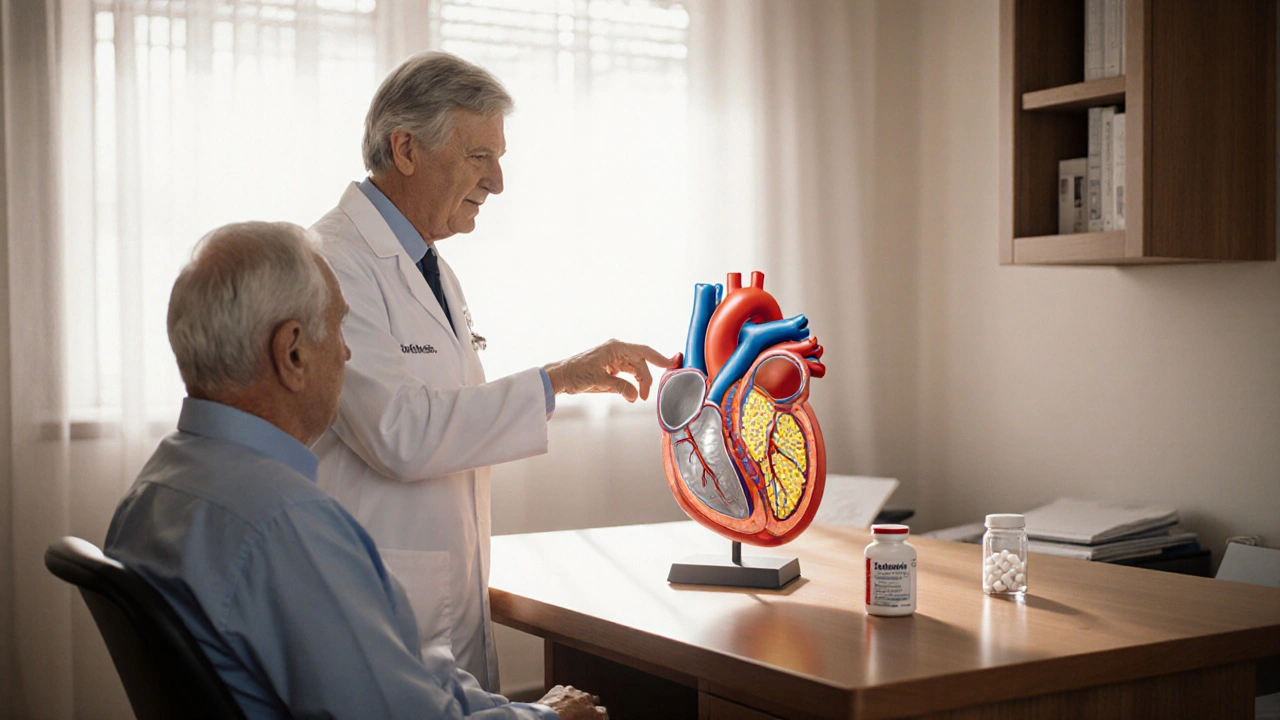Atorvastatin (Atorlip 5) vs Other Statins: Which Is Right for You?
 Oct, 14 2025
Oct, 14 2025
When your doctor tells you your LDL cholesterol is too high, the first line of defense is often a statin. Atorvastatin (sold as Atorlip5 in many markets) is one of the most prescribed options, but it’s not the only game‑in‑town. Knowing how it stacks up against other statins can help you pick the pill that fits your health goals, budget, and lifestyle.
What Is Atorvastatin (Atorlip5)?
Atorvastatin is a synthetic lipid‑lowering medication belonging to the statin class, used primarily to reduce low‑density lipoprotein (LDL) cholesterol and lower the risk of cardiovascular events. It was first approved by the FDA in 1996 and is available both as a brand‑name product (Atorlip5) and as a generic.
Typical dosing ranges from 10mg to 80mg once daily, and the drug works by inhibiting HMG‑CoA reductase, the enzyme that drives cholesterol production in the liver. For most patients, a 10‑20mg dose cuts LDL levels by roughly 30‑40%.
How Statins Work: A Quick Overview
The statin family shares a common mechanism: they block HMG‑CoA reductase, which slows the liver’s synthesis of cholesterol. With less cholesterol being produced, the liver pulls more LDL out of the bloodstream, lowering overall levels. This reduction translates into fewer plaque buildups, decreasing the chances of heart attacks and strokes.
Statins also modestly raise high‑density lipoprotein (HDL) and lower triglycerides, though those effects are secondary. Because the class works the same way, differences among individual statins boil down to potency, dosing flexibility, side‑effect profile, and cost.
Popular Statin Alternatives
Simvastatin is a medium‑potency statin that typically reduces LDL by 20‑35% at doses of 20‑40mg. It’s been on the market since 1991 and is often chosen for patients who need a modest cholesterol drop without a high daily pill burden.
Rosuvastatin is a high‑potency statin launched in 2003. Even a low 5‑10mg dose can slash LDL by 45‑55%, making it a go‑to for people with very high baseline cholesterol or those who can’t tolerate high doses of other statins.
Pravastatin is a lower‑potency, hydrophilic statin introduced in 1991. It reduces LDL by roughly 15‑30% and is praised for a gentle side‑effect profile, especially in patients with liver concerns.
Lovastatin was the first statin approved (in 1987). Doses of 20‑80mg lower LDL by about 20‑35% and are usually taken with meals to improve absorption.
All of these drugs fall under the broader category of statins, a class of cholesterol‑lowering agents that share the HMG‑CoA reductase inhibition mechanism.

Comparison Table: Atorvastatin vs. Common Alternatives
| Statin | Typical Daily Dose | LDL Reduction % (average) | Common Side Effects | Approx. Monthly Cost (US$) | FDA Approval Year |
|---|---|---|---|---|---|
| Atorvastatin (Atorlip5) | 10‑80mg | 30‑45% | muscle aches, elevated liver enzymes, digestive upset | 5‑15 (generic) | 1996 |
| Simvastatin | 20‑40mg | 20‑35% | muscle pain, insomnia, headache | 3‑12 | 1991 |
| Rosuvastatin | 5‑20mg | 45‑55% | muscle cramps, nausea, mild rash | 8‑20 | 2003 |
| Pravastatin | 10‑40mg | 15‑30% | fatigue, constipation, mild liver changes | 4‑10 | 1991 |
| Lovastatin | 20‑80mg (taken with food) | 20‑35% | gastro‑intestinal upset, muscle soreness | 2‑8 | 1987 |
Choosing the Right Statin for Your Situation
Here are the main decision points you’ll weigh when picking a statin:
- Potency needs - If your LDL is >190mg/dL, a high‑potency option like rosuvastatin or a high dose of atorvastatin may be required.
- Risk of muscle side effects - Patients with a history of myopathy often do better on pravastatin or low‑dose rosuvastatin because they are more hydrophilic and less likely to accumulate in muscle tissue.
- Drug interactions - Simvastatin is heavily metabolized by CYP3A4; it can clash with certain antifungals, antibiotics, or grapefruit juice. Atorvastatin also uses CYP3A4 but has a wider therapeutic window.
- Cost considerations - Generic atorvastatin and simvastatin are usually the cheapest, but insurance formularies may favor one over the other.
- Kidney function - Rosuvastatin requires dose adjustments in severe renal impairment, whereas pravastatin is more forgiving.
Talk with your clinician about these factors. A simple blood test after four weeks on a new dose will tell you if the LDL drop meets targets and whether any liver enzymes have risen.

Practical Tips if You Decide to Switch Statins
- Don’t stop abruptly. Most statins have a short half‑life, but an abrupt halt can cause a rebound rise in LDL. Transition over a week under medical supervision.
- Use dose‑equivalence charts. For example, 10mg of atorvastatin roughly equals 5mg of rosuvastatin or 20mg of simvastatin in LDL‑lowering effect.
- Monitor muscle symptoms. If you notice new aches, inform your doctor. They may order a creatine kinase (CK) test to rule out myopathy.
- Check liver function. Baseline ALT and AST should be measured before any switch and repeated after six weeks.
- Stay consistent with meals. Lovastatin and simvastatin absorb best with food, while atorvastatin and rosuvastatin can be taken any time of day.
Adhering to these steps helps you get the cholesterol‑lowering benefit without unexpected side effects.
Frequently Asked Questions
Can I take Atorvastatin with other heart medications?
Yes, atorvastatin is commonly prescribed alongside antihypertensives, aspirin, or beta‑blockers. However, discuss any potential interactions with your doctor, especially if you’re on CYP3A4 inhibitors like clarithromycin.
Is Atorlip5 the same as generic Atorvastatin?
Atorlip5 is a brand name for the 5mg tablet of atorvastatin. The active ingredient is identical to the generic version; the difference lies mainly in branding and pricing.
Why do some people experience muscle pain on statins?
Statins can affect muscle cells by reducing coenzyme Q10 levels, which some researchers link to soreness. Genetics also play a role; certain variants of the SLCO1B1 gene increase risk.
How long does it take to see LDL reduction after starting Atorvastatin?
Most patients notice a measurable LDL drop within two weeks, with the full effect typically reached after 4‑6 weeks of consistent dosing.
Are there natural alternatives that work as well as statins?
Dietary changes, exercise, and supplements like plant sterols can lower LDL modestly (5‑15%), but they haven’t matched the 30‑50% reductions seen with statins in clinical trials.

Beverly Pace
October 15, 2025 AT 06:46Choosing a statin is a moral responsibility to protect your heart.
RALPH O'NEIL
October 26, 2025 AT 20:33When evaluating statin options, consider the potency, side‑effect profile, and any potential drug interactions, especially with CYP3A4 metabolized medications.
stephen henson
November 7, 2025 AT 10:20Great rundown! 👍 If you’re starting a new statin, keep a journal of any muscle aches and bring it to your next appointment. 😊
Mark Wellman
November 19, 2025 AT 00:06Okay, so you’ve got this whole "statin showdown" thing and I’m sitting here feeling like I need a PhD just to pick a pill.
First off, the idea that one magic tablet will fix everything is kinda naive, ya know?
Atorvastatin does its job, sure, but it also loves to mess with your liver enzymes if you’re not careful.
And don’t even get me started on the muscle pains – they’re not just a "little soreness"; they can feel like you’ve run a marathon after a Netflix binge.
Then there’s rosuvastatin, which is marketed like the superhero of statins, but high potency means higher risk for kidney issues in vulnerable folks.
Pravastatin sounds sweet because it’s gentle, but the trade‑off is a modest LDL drop that might leave you stuck in the same risk bucket.
Simvastatin is old school, cheap, and works fine unless you’re guzzling grapefruit juice or some antibiotics – then it’s a disaster waiting to happen.
Lovastatin is a nostalgia piece; it’s still around but you have to take it with food, which adds another step to your routine.
The cost factor is real – generic atorvastatin can be cheap, but insurance formularies love to push you toward brand names that cost way more.
Switching between statins isn’t as simple as swapping a soda; you need a wash‑out period and proper monitoring.
Blood tests after four to six weeks are essential to catch any hidden liver spikes before they become a problem.
And let’s not forget the genetic side – some people have a SLCO1B1 variant that makes them super susceptible to myopathy.
Bottom line: talk to your doc, get those labs, and don’t just pick a statin because it’s on the front page of a blog.
Statins are powerful, but they’re not a one‑size‑fits‑all solution – treat them with the respect they deserve.
Erynn Rhode
November 30, 2025 AT 13:53Just a quick note on terminology: the article correctly uses “LDL reduction %,” but it would be clearer to say “average LDL reduction percentage.” Also, remember that “statin’s” with an apostrophe is a possessive form and not needed here.